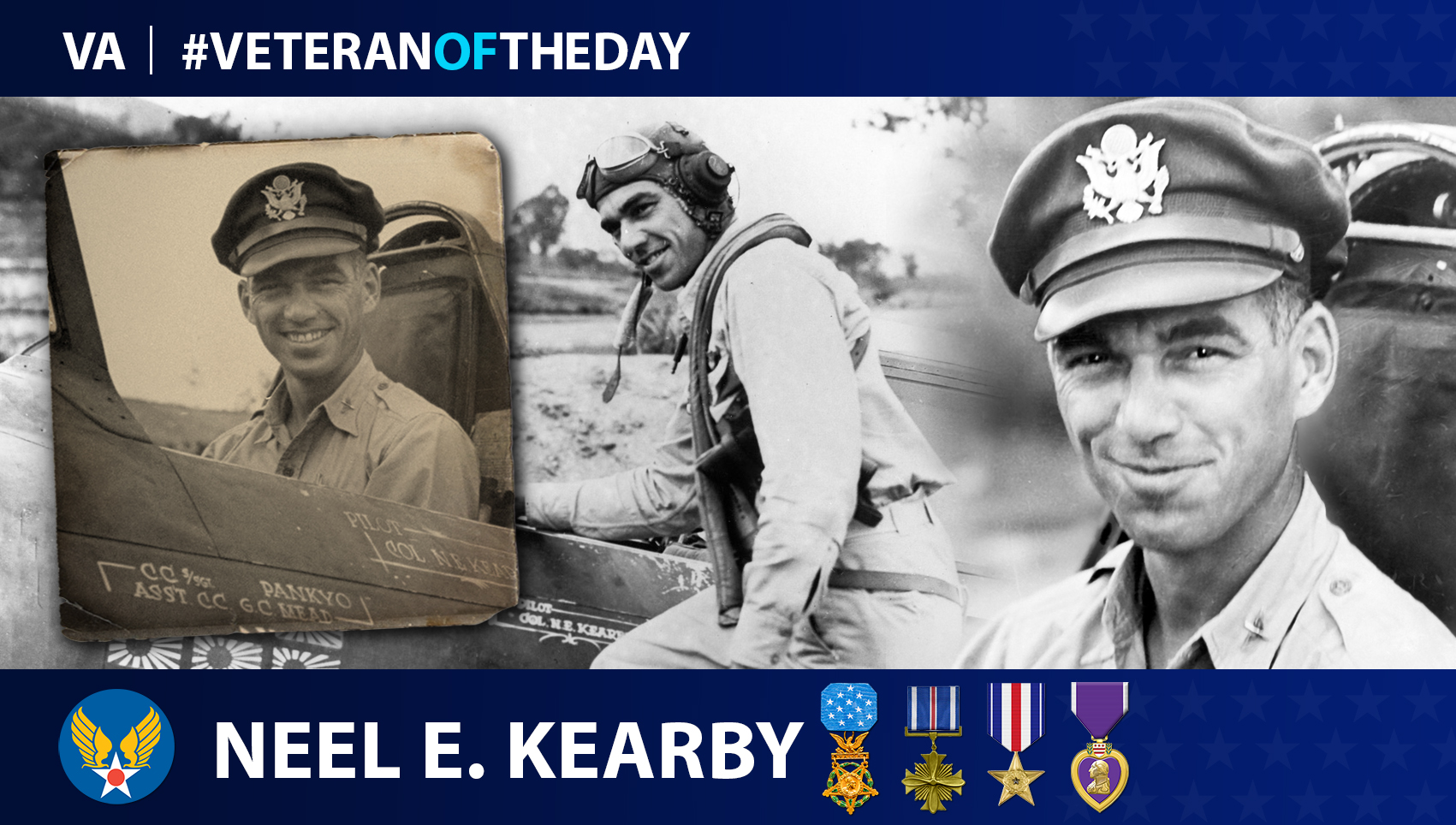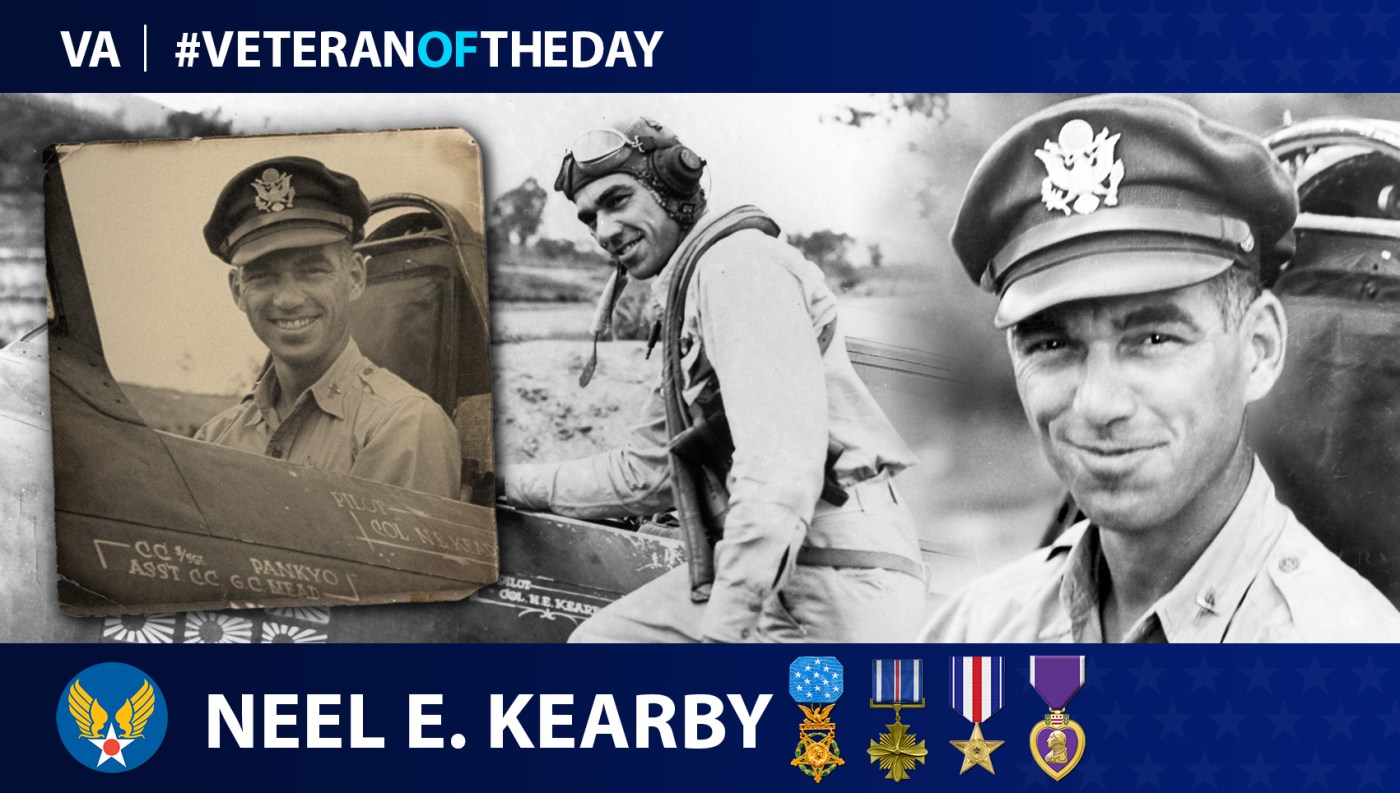
Today’s #VeteranOfTheDay is Army Air Forces Veteran Neel E. Kearby, who served as a fighter pilot during World War II.
To a generation of young Americans, the flying aces of World War I inspired many to follow in their footsteps to become fighter pilots. Neel Earnest Kearby was one of those who grew up captivated by the aces. He joined the Army Air Corps—later renamed the Army Air Forces—after earning a degree in business administration from the University of Texas in Austin in 1937. He completed flight training at Randolph Field in San Antonio. Afterward, he served with two flight squadrons at Selfridge Field, Michigan, before receiving command of the 14th Pursuit Squadron in the Panama Canal Zone.
After Panama, Kearby returned to the U.S. to command the 348th Fighter Group and deployed to the Pacific Theater. In this position, Kearby earned his reputation as a fighter pilot and an aggressive tactician. The 348th Fighter Group was the first unit in the Pacific Theater to fly P-47 Thunderbolts. While many dismissed the P-47 as an unsuitable aircraft to fly against the Japanese, Kearby exploited the P-47’s high altitude and diving capabilities to tremendous success.
On Oct. 11, 1943, the same day he was promoted to colonel, Kearby led a mission to scout enemy bases near Wewak, New Guinea. After his group completed its objective, they spotted a contingent of enemy aircraft and engaged with them despite being outnumbered. Amid the ensuing fight, Kearby shot down three enemy aircraft and two more who were pursuing another pilot in his group. He destroyed another enemy aircraft before finally retreating into the safety of the clouds. Kearby received a Medal of Honor for his actions and for destroying the most enemy aircraft in a single mission. By November, he had 12 aerial victories.
In the same month, Kearby was set to assume an administrative role at the Fifth Air Force Fighter Command. Never one to give up flying, he made sure he could still fly combat missions in his new role. True to his goals, he continued to fly combat missions and accumulated 22 aerial victories.
On March 5, 1944, Kearby led a fighter sweeper mission near Wewak, New Guinea. He engaged with several Japanese bombers preparing to land. However, he was hit by machine-gun fire during the fight, causing him to crash. His remains were not recovered until 1949. He was buried at Hillcrest Memorial Park Cemetery with full military honors.
During his service, Col. Kearby received a Medal of Honor, two Silver Stars, four Distinguished Flying Crosses, a Purple Heart and five Air Medals.
We honor his service.
Nominate a Veteran for #VeteranOfTheDay
Do you want to light up the face of a special Veteran? Have you been wondering how to tell your Veteran they are special to you? VA’s #VeteranOfTheDay social media feature is an opportunity to highlight your Veteran and his/her service.
It’s easy to nominate a Veteran. Visit our blog post about nominating to learn how to create the best submission.
Veterans History Project
This #VeteranOfTheDay profile was created with interviews submitted to the Veterans History Project. The project collects, preserves, and makes accessible the personal accounts of American war Veterans so that future generations may hear directly from Veterans and better understand the realities of war. Find out more at http://www.loc.gov/vets/.
Writer: Raymond Lin
Editors: Alexander Reza, Annabelle Colton
Researcher: Giacomo Ferrari
Graphics: Kiki Kelley
Topics in this story
More Stories
This week’s Honoring Veterans Spotlight honors the service of Army Veteran David Bellavia, who received a Medal of Honor from the Iraq War’s deadliest operation, the Second Battle of Fallujah.
This week’s Honoring Veterans Spotlight honors the service of Army Veteran Scotty Hasting, who served in Afghanistan.
This week’s Honoring Veterans Spotlight honors the service of Army Veteran Roy Sheldon, who served in 97th General Hospital in Frankfurt, Germany.






